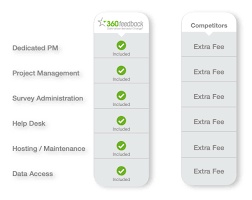In the landscape of modern organizational development, 360 degree feedback has emerged as a cornerstone for evaluating employee performance comprehensively. This feedback mechanism involves soliciting input from various sources, including peers, subordinates, managers, and occasionally clients, to offer a holistic perspective on an employee's strengths, weaknesses, and areas for improvement. Amidst the discussions surrounding this feedback process, a common question arises: Is 360-degree feedback anonymous? Let's delve into this question to understand the dynamics of anonymity in the context of 360-degree feedback.
Understanding Anonymity in 360-Degree Feedback
Anonymity in 360-degree feedback refers to the practice of keeping the identities of feedback providers confidential. In anonymous feedback processes, individuals providing feedback are not required to disclose their names or positions, ensuring that their responses remain anonymous to the recipient. The underlying rationale behind anonymity is to create a safe and conducive environment where feedback providers feel empowered to offer candid insights without the fear of reprisal or retaliation.
The Case for Anonymity
Proponents of anonymous 360-degree feedback highlight several potential benefits associated with this approach:
- Promoting Honest Communication: Anonymity can encourage feedback providers to express their opinions candidly, without concerns about potential repercussions. This can lead to more honest and constructive feedback, providing the recipient with valuable insights for personal and professional growth.
- Reducing Bias and Power Dynamics: Anonymity levels the playing field by mitigating bias and power dynamics that may exist within the organization. Feedback providers, regardless of their hierarchical position, can offer their perspectives freely, leading to a more balanced and objective assessment of the recipient's performance.
- Enhancing Trust and Confidentiality: Anonymity fosters a sense of trust and confidentiality in the feedback process. Feedback providers can feel assured that their responses will remain confidential, promoting transparency and openness in communication.
Challenges and Considerations
While anonymity in 360-degree feedback offers potential benefits, it also presents certain challenges and considerations that organizations must navigate:
- Accountability: Anonymity can sometimes lead to a lack of accountability in the feedback process. Without knowing the identities of feedback providers, recipients may find it challenging to follow up or seek clarification on specific comments, hindering their ability to take meaningful action on the feedback received.
- Trust and Transparency: Maintaining anonymity in the feedback process can erode trust and transparency within the organization. Recipients may feel frustrated or distrustful if they receive critical feedback without knowing who provided it. Lack of transparency can also hinder the development of open and honest communication channels within teams and departments.
- Actionability of Feedback: Anonymity can make it difficult for recipients to understand the context or intent behind specific feedback comments. Without knowing the identities of feedback providers, recipients may struggle to interpret feedback effectively and take actionable steps for improvement.
Finding a Balanced Approach
To address the challenges associated with anonymity in 360-degree feedback while leveraging its potential benefits, organizations can adopt a balanced approach:
- Transparency and Accountability: Encourage open communication and accountability by providing participants with the option to disclose their identities when providing feedback. This allows recipients to follow up or seek clarification on specific comments, promoting accountability and transparency in the feedback process.
- Training and Support: Provide training and support to both feedback providers and recipients to ensure they understand the purpose, process, and importance of 360-degree feedback. Educate participants on how to provide constructive feedback and how to effectively receive and act upon feedback received, regardless of whether it is anonymous or not.
- Cultivating a Feedback Culture: Focus on fostering a culture of open communication and continuous feedback within the organization. Encourage leaders to lead by example and demonstrate receptiveness to feedback, creating an environment where employees feel empowered to share their perspectives openly and honestly.
Conclusion
Anonymity in 360 degree feedback is a nuanced aspect that requires careful consideration by organizations. While anonymity can promote honest communication and mitigate bias, it also poses challenges related to accountability, trust, and transparency. By adopting a balanced approach that values transparency, accountability, and open communication, organizations can harness the power of 360-degree feedback to drive employee development and organizational success effectively.


No comments yet